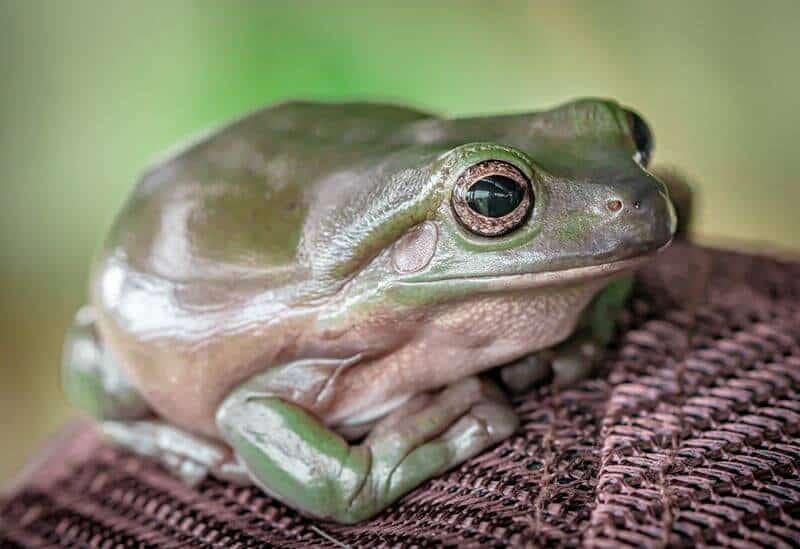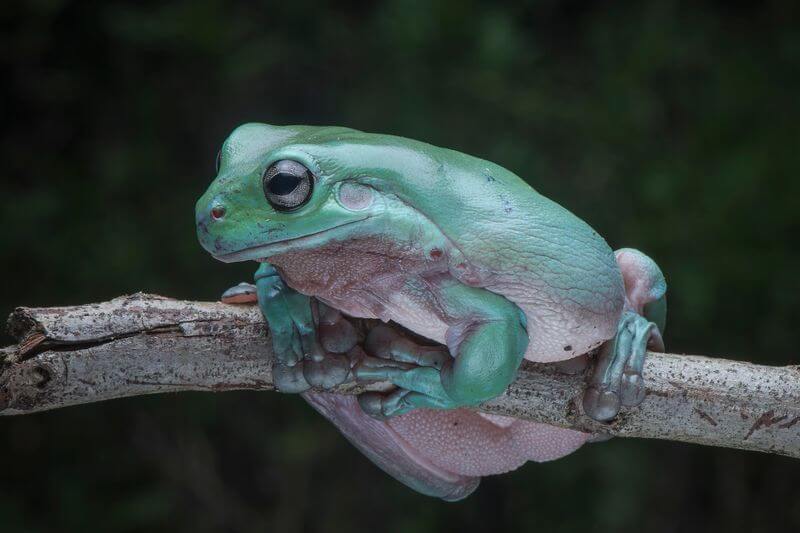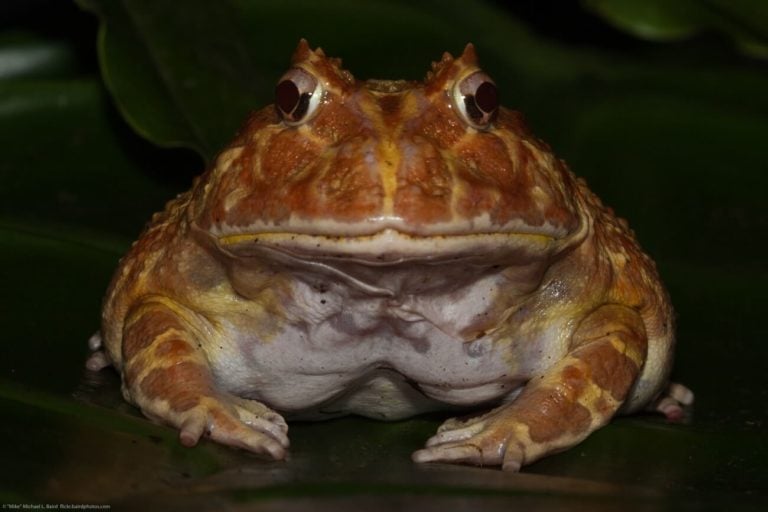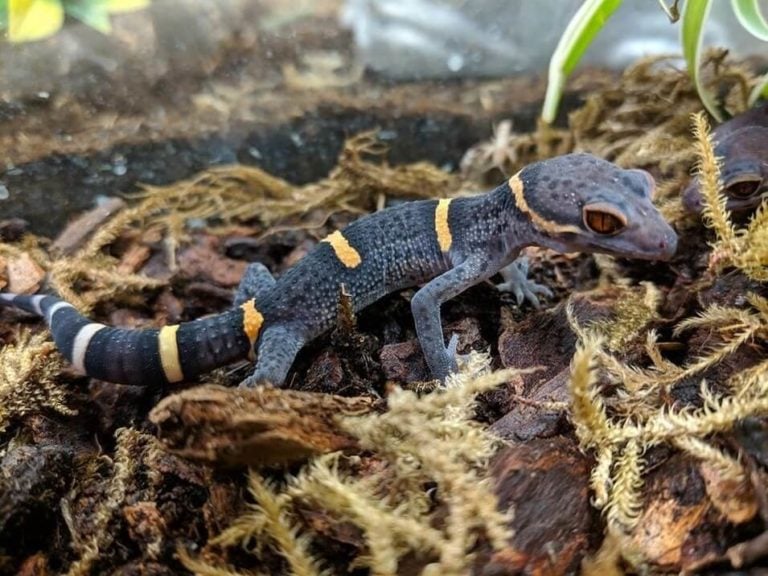The White’s tree frog is an adorable and friendly amphibian that’s quite a popular pet. Due to their appearance and low-maintenance care requirements, you’ll see these little critters in captivity quite often.
This guide goes over everything you need to know about White’s tree frog care. You’ll learn about their lifespan, diet, size, habitat setup, and more!
Table of Contents
Species Summary
White’s tree frog (Litoria caerulea) is a beginner-friendly amphibian species that’s gained immense popularity recently. Thanks to its quirky looks and docile personality, it has become a beloved species of pet frog in the community.
This frog was named after the naturalist who discovered it in Australia, John White. White first described the amphibian in 1790. Its natural distribution goes beyond Australia. These frogs are also native to Indonesia and New Guinea.
In the wild, White’s tree frogs spend most of their time exploring the tree tops. While that behavior may seem difficult to support in captivity, these frogs are surprisingly easy to care for. They’re hardier than other frog species thanks to their waxy skin, making them more tolerant of arid regions.
Despite their beefy build, White’s tree frogs don’t need massive enclosures. Unlike other tree-climbing species, White’s tree frogs are relatively sedentary. They prefer calmer and more relaxed living, making them the perfect species to keep at home.
Appearance & Colors
This unique frog species is renowned for its somewhat odd appearance. They have a look that some would describe as “Dumpy,” which is why they have the common moniker of “Dumpy Tree Frog.”
When most people think of tree frogs, they picture small and agile creatures. However, White’s tree frog is quite chubby. They have a beefier and more bulbous build.

Pair that with their smiling mouths and the constantly tired look in their eyes; these frogs are one of the goofier-looking species in the amphibian kingdom!
Like most frogs, White’s tree frogs have large eyes. However, White’s tree frogs are unique because they have horizontal pupils. Eyes are usually yellow-colored or dark brown, and adult frogs have a thick band of fatty tissue that develops on the top and sides of the head.
The frog’s belly is round. It’s typically off-white or slightly pink. The same goes for the circular toe pads that develop on the frog’s large fingers and the webs between them.
While White’s tree frog still has the absorbent skin of other amphibians, they are hardier than other frogs. The waxy skin helps retain moisture during the dry season. It also has great antifungal and antibacterial properties, making this species less susceptible to illness.
The top of the frog’s body can vary from minty blue to bright green. There are several morphs available with distinct detailing, like white spots. Some of the most popular include the snowflake, blue-eyed honey, and blue phase.
Lifespan
The average White’s tree frog lifespan is seven to ten years. However, that’s the standard life expectancy. This species can live significantly longer.
This species can live over a decade with pristine care and good health. Some of the oldest White’s tree frogs in captivity reportedly lived 20 years!
Of course, there are no guarantees. Many factors impact a frog’s life expectancy, including the quality of care you provide and genetic predispositions out of your control. The best thing you can do is give the best care possible to keep your pet happy and healthy.
Average Size
The average size of an adult White’s tree frog is three to five inches. They’re considerably smaller when you buy them as juveniles. Most herpetology buffs get these frogs when they’re only an inch from snout to vent.
It only takes a few months for the frog to grow to three inches. By about ten months of age, they will reach their full mature size.
White’s Tree Frog Care
White’s tree frogs are very beginner-friendly. Many enthusiasts recommend them to first-time frog owners because of their resilience and easy-going nature.
However, that doesn’t mean the species doesn’t have specific care requirements. Like any other animal you raise in captivity, you must maintain a healthy environment, provide a top-notch diet, and do what you can to avoid health complications. Here are the core guidelines you need to know when it comes to White’s tree frog care.
Enclosure Size
This species of frog spends most of its time climbing trees in the wild. As a result, you need to focus on verticality when creating a habitat that mimics the frog’s natural environment.
The smallest enclosure you can use is a 15- or 20-gallon glass terrarium. Ideally, it should measure 18 inches wide, 18 inches deep, and 24 inches tall. An enclosure of that size will house two adults or up to four juveniles.
While you could use a standard glass aquarium, it’s best to go for a terrarium built for amphibians. Most aquariums built for fish prioritize length, but you need an enclosure with more height. A square or hexagonal glass terrarium is best.
Whatever you use, make sure it’s made of glass and has a tight-fitting lid. Thanks to the frog’s webbed feet and toe pads, they will climb the glass walls. You might notice your White’s tree frog hanging out near the lid. If your cover is loose, the frogs will escape!
Habitat Setup
The key to keeping your White’s tree frog happy and healthy is to create a natural-looking environment that caters to its lifestyle.
Before adding anything to the enclosure, consider covering the back and lower perimeter. Attach pieces of dark-colored paper to the enclosure’s exterior to cover the entire backside. Do the same along the terrarium bottom, covering several inches of the bottom section.
White’s tree frogs don’t understand transparency. As a result, they will often see something on the other side of the glass and try to get to it, injuring their snouts in the process. Plus, the covering creates a dark and secure hangout area they can use when resting during the day.
For the substrate, you have a few options. Some owners like to use several pieces of dampened paper towels. The material is cheap, easy to swap out, and holds onto moisture well. But if you want a more natural look, use coconut fiber or amphibian-safe soil.
Add a thin layer of gravel to the bottom of the terrarium before creating a stable foundation for your chosen substrate. Avoid adding large pieces of bark or stone onto the top of the substrate. Your frogs could ingest them and experience compaction issues.
On top of the substrate, consider adding clumps of sphagnum moss as another accessory to support the humidity levels.
After you have the substrate laid, you can get to the fun part! White’s tree frogs need several climbing structures. Get creative and add several natural-looking decorations.
Cover the back with large pieces of bark. Situate them diagonally and position them a few inches from the glass to allow frogs to explore both sides. Many frogs use the back of the bark as a dark hiding spot.
Next, add cork bark and several climbing branches. You can also use bendable vines, PVC pipes, small perches, and more.
For plants, you can use either fake or live varieties. If you use live plants, keep them in pots for easy removal when cleaning. Use soft plants with plenty of foliage to create natural cover.
Temperature & Lighting
During the day, White’s tree frogs need temperatures between 75 and 85 degrees Fahrenheit. At night, the temperature can be as low as 65 degrees. However, a slightly warmer 68 degrees is preferable.
If you live in an area that gets colder nights, invest in under-tank heaters and heat emitters to keep your frogs warm.
These frogs do need a temperature gradient. Install a basking light or heater outside the terrarium to create a warmer basking area. You can position the lamp towards the top of the tank near a high-up climbing branch to create the ideal temperature gradient.
White’s tree frogs are nocturnal. As a result, you don’t need anything special like UVB lamps. Some owners like to install low-output UVB bulbs, but that’s optional.
A standard lighting rig will do. While the frogs are nocturnal, they still need a day/night cycle to maintain their circadian rhythm. Put your lights on a 12-hour timer.
You can use an infrared nocturnal bulb at night to observe your frogs when they’re most active.
Humidity
White’s tree frogs need their enclosures to have relative humidity levels between 60 and 70 percent. Install a hygrometer and closely monitor humidity levels throughout the day.
To lower humidity, open vents on the enclosure’s lid to allow fresh air to seep in. To increase humidity, you can mist the tank daily with dechlorinated water. Alternatively, you can install humidification systems, automatic misters, or rain bars.
Always check your hygrometer. While White’s tree frogs are more resilient than other species, improper humidity levels can cause health issues.
Water
The final addition to your frog’s tank should be a water dish. The dish should be big enough for your frogs to get into. White’s tree frogs like to soak to rehydrate.
Never use plain tap water when filling the dish or misting the tank. Your frogs can absorb the metals and chemicals in your tap water through their skin. You need to use dechlorinated water.
There are many great water conditioners available. Conditioners remove contaminants, making your water safe to use.
Watch the water dish closely. Because White’s tree frogs sometimes defecate in these dishes, you’ll need to clean and replenish the water frequently.
Food & Diet
In the wild, White’s tree frogs eat a variety of foods. In captivity, they do best on a diet with several insect types.
These frogs can eat:
- Crickets
- Dubia roaches
- Mealworms
- Beetles
- Moths
- Grasshoppers
- Earthworms
- Waxworms
- Hornworms
Crickets should be the frog’s diet staple. However, you can add other foods periodically to give your frog a well-rounded diet.
Always use gut-loaded and insecticide-free insects. Purchase your insects from a store and avoid feeding your frog anything you catch outside. Gut-loaded insects are safe and nutritious.
You must dust some in calcium and multivitamin supplements when you feed crickets. Dusting is crucial because it provides your frogs with much-needed vitamins and minerals they don’t get enough of through their diet. Ideally, you should dust the food once per week.
How much you feed your frogs will depend on their age. Regardless, never feed insects that are larger than the width of the frog’s eyes. Any bigger than that could result in choking.
Juveniles should eat daily. Provide enough food that they can eat in 30 minutes. As they get older, you can transition to feeding your frogs every two or three days.
Adult White’s tree frogs will need to eat larger insects a few times per week. Generally, it’s best to stick with four larger insects per feeding session. White’s tree frogs are prone to obesity, so you must avoid overfeeding.
During a feeding session, you can place live insects into the terrarium and allow your frogs to hunt them down. Alternatively, you can feed frogs directly with soft-tipped forceps.
Potential Health Issues
White’s tree frogs are resilient and can stay healthy if you keep environmental conditions in check. However, there are a few health issues to be wary of.
The first is a condition called chytridiomycosis. It’s a fungal disease that spreads quickly and can be fatal. Symptoms of chytridiomycosis include lethargy and weight loss.
If you suspect chytridiomycosis, take your frog to a vet immediately after quarantining. Few treatments are available, but your vet may be able to address the disease.
White’s tree frogs are also susceptible to respiratory infections and bacterial problems. The best way to avoid chytridiomycosis and other diseases is to maintain the enclosure. Keep temperature and humidity levels stable, and clean the terrarium regularly.
Spot clean messes as soon as possible and do a full sanitary breakdown once a month. When doing a deep clean, wipe every surface with an amphibian-safe sanitizer to keep fungus and bacteria at bay.
Remember to dust your frog’s food with calcium and multivitamin powders. Failing to do that could make your frog experience metabolic bone disease. The debilitating disease causes the bones to become frail and fracture-prone.
Behavior & Temperament
One of the best parts of White’s tree frog care is that these critters are incredibly easy-going. They live sedentary lifestyles, spending most of the day sleeping. Many frogs will hide out in darker areas until sundown.
While they become more active at night, they’re not rambunctious. White’s tree frogs are docile and peaceful. You might see them climbing the glass walls or exploring the decor you provide. But beyond that, the frogs stay relaxed.
In the wild, White’s tree frogs usually live alone. However, you can keep multiple frogs together with a large enclosure.
These frogs do well in pairs or trios. The most important thing is that you only keep frogs of the same age and size together. Otherwise, smaller frogs might become food for the bigger ones!
Handling Them
White’s tree frogs tolerate handling well. They’re not the type of pet you will carry around everywhere, but they do just fine with a few minutes of handling.
Before handling your frogs, wash your hands thoroughly. Use only warm water and rinse with dechlorinated water. Avoid using any soap.
Amphibians absorb chemicals through their skin, so anything on your hands could harm your frog. Wash your hands before and after handling to keep them safe!
Closing Thoughts
White’s tree frog care is something that anyone can manage, which is why they’re such a popular pet for beginners. In fact, we find ourselves recommending them all the time!
If you have any questions about the information in this care sheet, send them our way. It’s fun for us to connect with our readers and lend a hand whenever possible.



